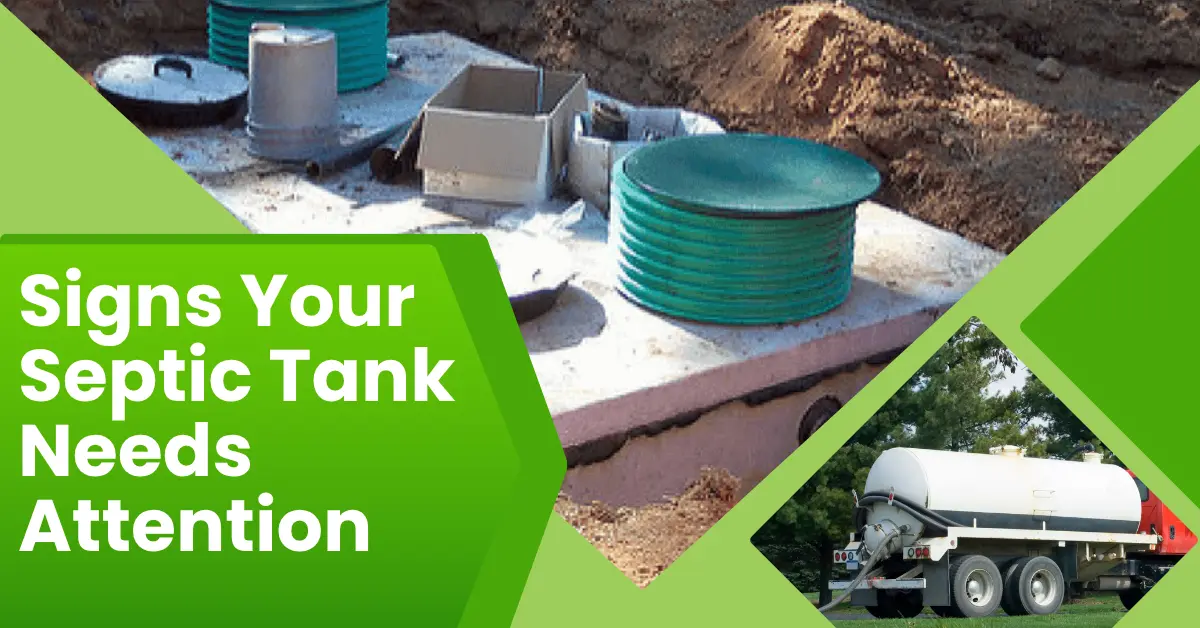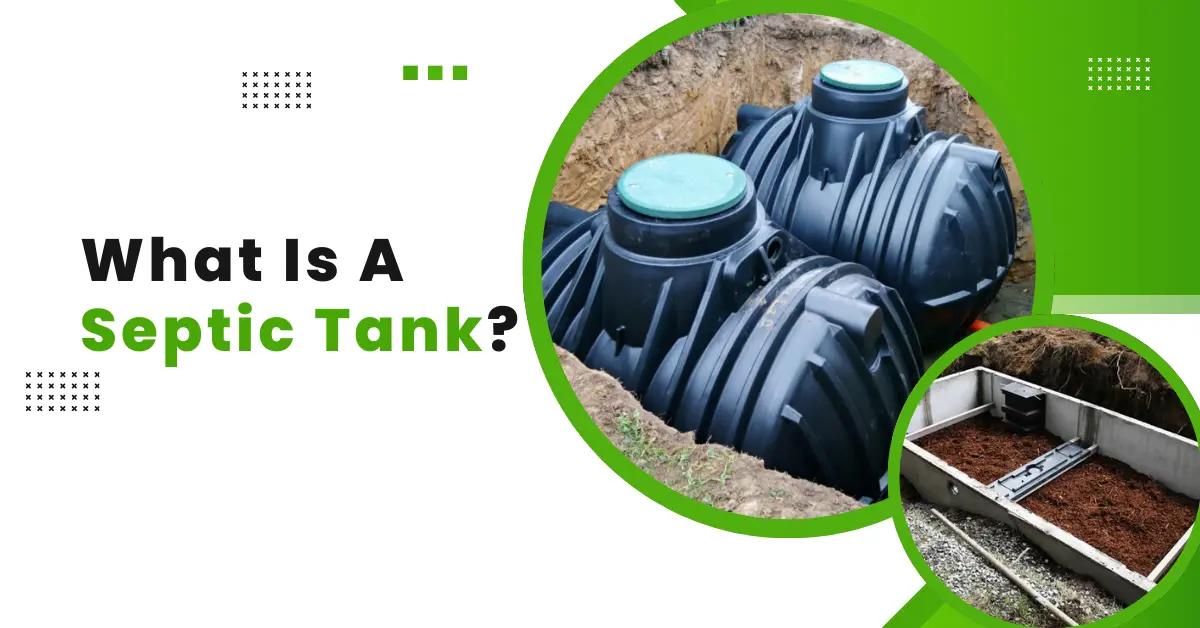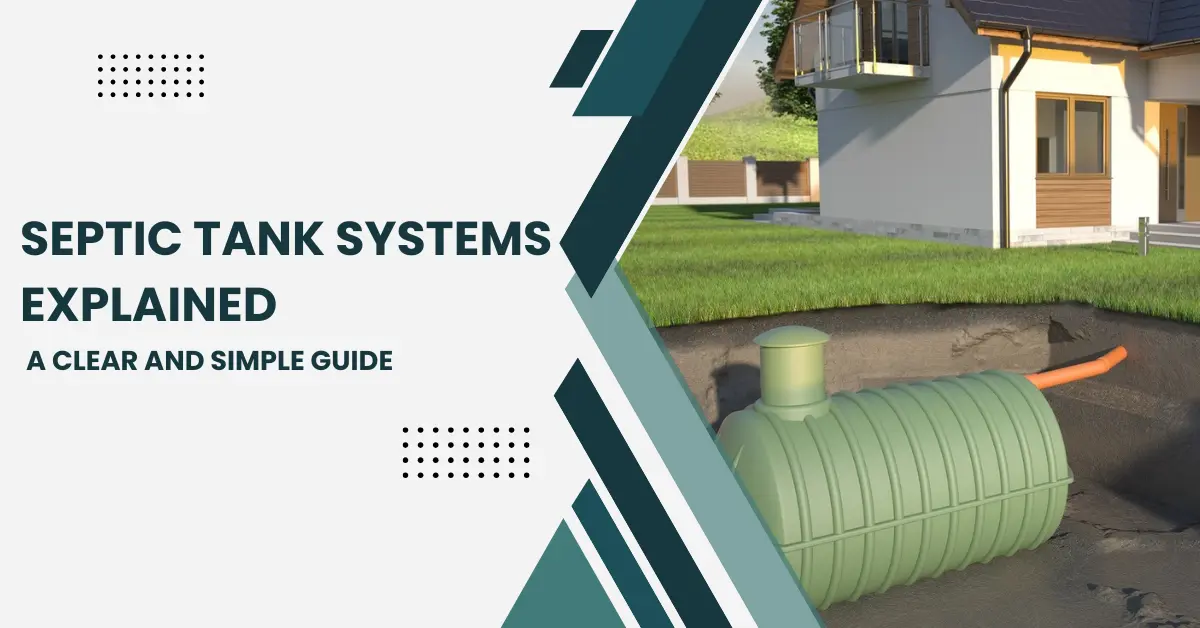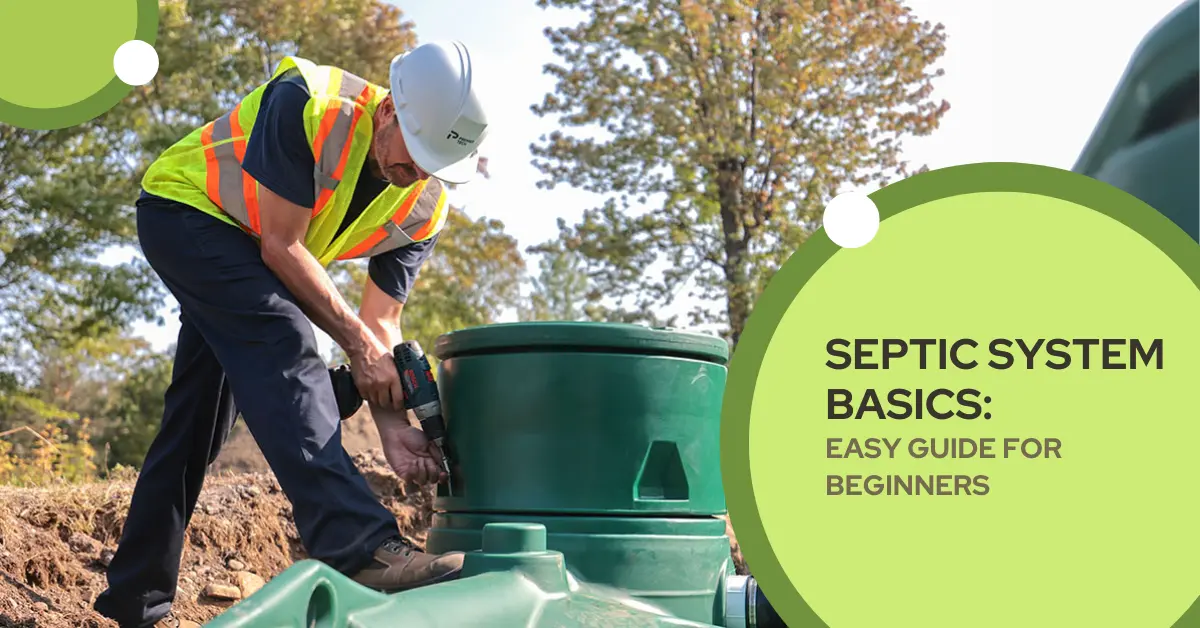One gurgle, one foul odor, one soggy patch, your septic tank is trying to tell you something. Most homeowners ignore these subtle signs of a septic tank problem until the damage is done.
Issues like a blocked drainfield, an overflowed tank, or tree roots infiltrating the system can cause sewage to back up, pose health risks, and result in costly repairs running into thousands of dollars.
Here’s the good news: most septic problems are preventable. Regular pumping, being smart about what you flush, and keeping an eye out for warning signs can save your home and your wallet.
In this guide, we’ll cover the top signs to watch for, break down what causes them, and show you how to handle them, from small fixes to when it’s time to call in the pros.
We’ll also share simple prevention tips and help you decide if your system needs repairs or a full replacement.
Therefore, let’s get started!
Why Does Recognizing Septic Problems Early Matter?
Catching septic issues early protects your health, home, and environment, and ignoring them can lead to serious, costly problems.
Here’s why catching these issues early truly matters.
1. Health Risks
Untreated sewage can contaminate drinking water sources. It may lead to illnesses such as dysentery, hepatitis, and acute gastrointestinal infections.
Pathogens like E. coli and Salmonella can proliferate, especially when systems leak into groundwater or nearby water bodies.
Additionally, the gases emitted from malfunctioning septic tanks, including hydrogen sulfide and methane, can be toxic to humans and pets.
2. Environmental Concerns
Excess nitrogen and phosphorus from untreated sewage can promote harmful algal blooms (HABs) in water bodies.
These blooms can produce toxins harmful to aquatic life and humans, and eventually lead to beach closures and fish kills.
Contaminated groundwater affects private wells, makes water unsafe to drink, and causes health problems.
3. Property Damage and Costly Repairs
Minor repairs, such as unclogging a pipe, typically range from $200 to $600, while major fixes like drain field repairs can exceed $5,000.
In some cases, homeowners may face repair costs between $3,000 and $7,000, based on the extent of the damage.
Moreover, untreated sewage backups ruin floors, walls, and yards, adding extra repair costs.
4. Regulatory Issues and Potential Fines
In some regions, fines for illegal septic systems range from $500 to $10,000 per violation.
Some states impose daily fines until the issue is resolved, and repeat offenders may face even higher fines.
Additionally, authorities may require homeowners to repair or replace non-compliant systems at their own expense, with costs potentially reaching up to $15,000.
Top 10 Clear Signs of a Septic Tank Problem
Below are the top 10 clear signs of a septic tank problem that every homeowner should recognize before minor issues turn into major.
1. Slow-Draining Fixtures
Slow drains in bathtubs, sinks, or toilets often signal a clog. However, if multiple fixtures drain sluggishly at once, the septic system might be the issue.
Regular clogs usually affect one drain, like hair in a shower. But septic slow drainage affects the whole house, often due to a full tank or a failing drainfield.
Persistent slow flow signals a bigger system issue.
Remedy
If multiple drains are affected, call a septic technician to inspect for buildup or tank overload. Regular pumping and mindful water use help prevent this.
2. Water or Sewage Backup Indoors
When toilets, sinks, or drains begin to back up with sewage or wastewater, it’s a clear warning that your septic system is clogged.
This is often the most urgent sign and indicates that the tank or drainfield may be full or blocked.
Immediate attention is needed because sewage backups can pose serious health hazards, damage your home’s plumbing, and cause costly repairs.
According to the Environmental Protection Agency (EPA), backups are one of the most common signs of septic failure and should never be ignored.
Remedy
Stop water usage immediately. Get your tank inspected and pumped by a professional.
If backups continue after pumping, the issue may lie in the drainfield or plumbing system.
3. Gurgling or Bubbling Noises in Pipes
Gurgling sounds often mean that air or wastewater is having trouble moving through your pipes. In a septic system, it can be a sign of a clog or a failing drainfield.
A little gurgling now and then might be normal, but loud or frequent bubbling after flushing or draining usually means your septic system is under stress and needs a checkup.
Remedy
Have your system checked for venting issues, clogs, or improper drainage. Early checkup can prevent full backups.
4. Lush or Bright Green Patches of Grass
Green, lush patches over your septic system may look healthy, but they often signal trouble. Spongy or extra-vibrant grass usually means wastewater is leaking, adding excess nutrients to the soil.
While this speeds up grass growth, it also indicates septic leakage, which can harm soil and pollute groundwater.
Remedy
Have the system inspected for cracks or leaks. Reduce water usage and schedule maintenance.
This issue can stress the soil and eventually lead to surface contamination.
5. Foul Odors Around Tank or Indoors
Rotten egg or sulfur-like smells near your septic tank or inside the home often mean sewage gases are escaping due to cracks, leaks, or blockages.
Persistent bad odors are a serious warning sign of system failure and pose health risks from exposure to harmful gases such as hydrogen sulfide.
In some cases, a slow leak into septic tank allows wastewater to gradually seep in or out, creating persistent odors and moisture issues over time.
Remedy
Inspect tank lids, plumbing traps, and the surrounding soil.
Strong or persistent odors warrant a professional inspection for leaks or damage.
6. Contaminated Well Water Nearby
Failing septic tanks can leak pathogens, nitrates, and other contaminants into groundwater, which may feed nearby wells.
If your well water tastes, smells strange or causes health symptoms, get it tested regularly, especially if you live near a septic system.
Remedy
Test your well water at least once a year or immediately if your septic system shows issues.
Install backflow preventers and ensure your septic tank is far enough from your well (typically 50–100 feet minimum, based on local codes).
7. Standing Water or Damp Ground Near Tank
Look for soggy patches, puddles, or unusually damp soil above or near your septic tank and drainfield, especially after dry spells.
This usually means the drainfield is failing, and it eventually causes wastewater to surface instead of being absorbed.
It’s a clear warning of septic failure and risks contaminating nearby water sources.
Remedy
Avoid using the plumbing until inspected. You may need the tank pumped or the drainfield professionally evaluated.
Redirect surface water away from the system to avoid oversaturation.
8. Tree or Shrub Root Intrusion
Roots naturally seek moisture and can invade septic pipes or the drainfield. Over time, this intrusion may lead to a leaking septic pipe, which compromises the flow and can cause untreated waste to seep into the soil.
Slow drains, backups, or wet spots near roots are warning signs. Keep trees and large shrubs planted far from your septic components to prevent damage.
Remedy
Remove trees or relocate them away from your system (minimum 20 feet is ideal). Root barriers and regular inspections help prevent long-term damage.
9. Frequent Need for Pumping or Service
If your septic tank requires pumping more often than the recommended 3 – 5 years, it may be a sign of excessive water use, system damage, or drainfield failure.
Frequent servicing could mean solids are escaping into the drainfield, which can clog it and cause system failure.
Remedy
Limit water use, fix leaky toilets, and avoid flushing non-degradable items.
A professional can check for structural problems or excess sludge flow to the drainfield.
10. Algae Blooms in Nearby Water
Excess nutrients like nitrogen and phosphorus from leaking septic systems can cause harmful algal blooms (HABs) in lakes and rivers.
HABs reduce oxygen in water, kill fish, and produce toxins harmful to wildlife and humans. The EPA warns that septic failures significantly contribute to these environmental problems.
Remedy
Ensure your drainfield and tank are properly maintained. Upgrade outdated systems to protect the environment.
Causes Behind Septic Tank Problems
Most problems stem from preventable habits or overlooked maintenance, but environmental and design factors can also play a major role.
1. Tank Overuse or Lack of Maintenance
Excess water use can overpower the septic tank. It pushes the solids into the drainfield and causes clogs or backups.
Regular pumping every 3 – 5 years helps prevent overload and keeps the system running smoothly.
2. Heavy Rainfall and Flooding
Excess rain or flooding can fill your drainfield. As a result, it reduces the ability to absorb wastewater.
This often leads to a septic tank percolation problem, where the soil becomes too saturated to allow proper filtration.
When this happens, wastewater may rise to the surface or back up into the home.
3. Flushing Non-Degradable Materials
Items like wipes, feminine hygiene products, diapers, and grease don’t break down in the tank.
These materials build up quickly, block pipes, and can cause expensive system failures.
4. Incorrect System Design or Poor Installation
If your septic system isn’t sized correctly or installed with proper soil and drainage planning, issues are bound to happen.
layout, incorrect slope, or an undersized tank can lead to early system failure, even in newer setups.
What to Do If You Notice These Signs?
Here’s what you should do immediately to protect your home, health, and environment.
1. Take Immediate Action
If you see sewage backups, standing water, or foul odors, stop using water in the house as much as possible.
Continued use can worsen backups and spread contamination. Turn off dishwashers, laundry machines, and minimize toilet flushing.
2. Contact a Licensed Septic Professional
Call a certified septic service provider or plumber with experience in septic system inspections.
Ask for a full tank inspection, drainfield assessment, and sludge level measurement to determine the root issue.
3. Follow Basic Safety Guidelines
- Avoid walking or digging near the septic tank or drainfield.
- Keep children and pets away from the affected area.
- Don’t attempt to open the tank yourself.
- If contamination is suspected, avoid using well water until it’s been tested.
Prevention Tips to Avoid Septic Issues
Here are the top tips every homeowner should follow.
1. Stick to a Regular Pumping Schedule
Over time, solids build up in your tank and need to be removed.
For most households, pumping every 3 – 5 years is ideal. Larger families or homes with garbage disposals may need it more often.
Keep a maintenance log and mark your calendar for inspections.
2. Watch What You Flush or Pour
Don’t flush:
- Wipes (even “flushable” ones)
- Feminine products
- Diapers
- Cat litter
- Grease, oil, or harsh chemicals
These items don’t break down properly and can clog pipes or disrupt the natural bacteria in your tank.
3. Landscape with Septic Safety in Mind
To keep your septic system safe and functioning, avoid planting trees or shrubs with deep roots near the tank or drainfield, as they can damage pipes.
Also, never drive or park heavy equipment over the system, and don’t build patios or decks on top of it.
Instead, stick to shallow-rooted grasses and maintain a clear buffer zone around both the tank and the drainfield to prevent interference.
4. Stay Septic-Smart Through the Seasons
During wet weather or snowmelt, avoid doing multiple loads of laundry in a single day, as this can burden your septic system.
Check for pooling water near the drainfield, and ensure your gutters direct rainwater away from the septic area.
In dry months, water your lawn responsibly; too much water can still overload a weak system.
Also, keep an eye out for unusually green or lush patches of grass, which may indicate a leak or septic issue.
FAQs
1. How often should a septic tank be pumped?
Most residential septic tanks should be pumped every 3 to 5 years, based on household size, water usage, and tank capacity. Homes with heavy use of garbage disposals may require more frequent pumping. A professional inspection can help determine the best schedule.
2. Can I fix a septic problem myself?
Minor issues like slow drains or isolated clogs might be handled with safe DIY methods. However, most septic issues should be handled by a licensed professional, especially if there’s sewage backup, standing water, or structural concerns. DIY repairs can lead to bigger, more expensive problems if done incorrectly.
3. How do I know if my septic tank is full?
A full tank often shows warning signs like,
- Slow drains throughout the house
- Gurgling sounds from pipes
- Sewage backing up into toilets or tubs
- Foul odors around the tank or yard
- Lush grass directly above the tank
4. What are the early signs of septic tank failure?
Early signs of septic trouble include water or sewage backing up into the house, soggy spots near the drainfield, and unusual odors inside or around the home. You might also notice toilets and sinks draining slowly or see unusually bright green patches of grass over the tank or drainfield area.
5. Can a clogged drain mean septic tank issues?
Yes, a single clog is common, but if multiple drains are slow or you hear gurgling, it could point to a septic issue. A backed-up tank or failing drainfield can create pressure and block water flow.
6. What does a septic tank smell like when it’s going bad?
The most common smell is a rotten egg or sewage-like odor, caused by hydrogen sulfide and methane gases. These smells can appear near indoor drains, around the yard, or above the septic tank itself. Persistent odors are a clear red flag that the system needs inspection.
Final Thoughts
From slow drains and gurgling pipes to foul odors and soggy patches in your yard, the signs of a septic tank problem are often subtle, but they’re your early warning signals.
Catching these issues early can prevent serious damage, protect your home and health, and save thousands in costly repairs.
Regular maintenance, smart usage habits, and quick responses to the warning signs are your best defense against septic disasters.
If you’ve noticed even one of the signs we covered, don’t wait. Schedule a professional septic inspection today.
Flush smart, live clean!






